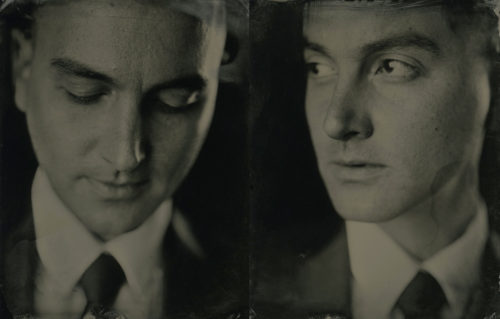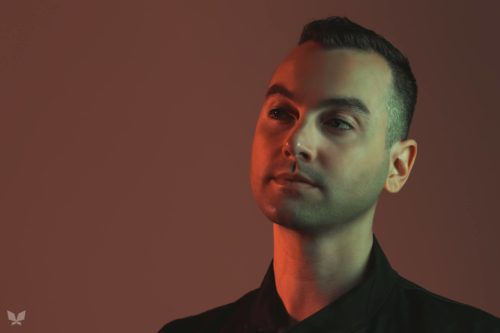Day for Night 2017 Preview: Hescher
 The relationship between sound and pictures is fascinating to me; it seems counterintuitive to think these two, seemingly disparate sensory pieces would fit together so tightly, would mesh together so well. And yet, they do. We hear a song in a movie trailer, and from then on, every time we hear that song, we “see” that movie scene in our minds. Heck, I’ve been having that happen for months now — every time I hear Led Zeppelin’s “Immigrant Song,” I’m suddenly remembering Thor fighting the Hulk. Those two things are now joined for me.
The relationship between sound and pictures is fascinating to me; it seems counterintuitive to think these two, seemingly disparate sensory pieces would fit together so tightly, would mesh together so well. And yet, they do. We hear a song in a movie trailer, and from then on, every time we hear that song, we “see” that movie scene in our minds. Heck, I’ve been having that happen for months now — every time I hear Led Zeppelin’s “Immigrant Song,” I’m suddenly remembering Thor fighting the Hulk. Those two things are now joined for me.
Music can define a film, or even a genre — see “Tubular Bells” and every creepy movie ever — and it can break a film, too; every time I think of the admittedly-mediocre Tom Cruise pseudo-historical flick The Last Samurai, literally all I can remember is that the film reel had melted somehow, so the Japanese-style music was warped every so slightly, enough that it made me feel queasy to hear it. Music and the moving picture are tied together in a lot of ways.
This is partly why I’ve always been particularly interested in music that has some sort of “cinematic” feel to it, whether it’s the darkened-street espionage soundtracks of Snooze or the half-remembered soundtrack to ’80s animated cult classic Rock & Rule (which I sung to myself for years before I remembered that, holy crap, that was from a movie I saw as a kid) or the aliens contacting the Earth in pretty much every M83 song I can recall or the unmistakeable score to the movie Glory, bits of which have popped up everywhere since that film was released.
 I explain all this to say that when I first heard about singer/songwriter/producer Cory Sinclair‘s new solo project, Hescher, and that it was influenced by theater and cinema in equal parts, my immediate thought was, “that makes sense, and I bet it’s really good.”
I explain all this to say that when I first heard about singer/songwriter/producer Cory Sinclair‘s new solo project, Hescher, and that it was influenced by theater and cinema in equal parts, my immediate thought was, “that makes sense, and I bet it’s really good.”
Happily, it does, and it most certainly is. If you’re a fan of Houston music, you probably already know Sinclair from his days as the frontman for The Manichean, where every performance was part about the music and part about, well, the performance.
I’ve witnessed shows where Sinclair had the entire audience throw rose petals in the air at the climax of a song, and shows where he literally danced on the edge of a high roof as his bandmates roared and trembled their way through the music. Going to see The Manichean play, I always wondered what would come next…and that’s no bad thing if you’re in a band and trying to capture people’s attention.
So it makes perfect sense to me that with Hescher, Sinclair is melding that performance aspect, that theatrical, dramatic aspect, more directly with his own music. And appropriately, he’s already been busy creating videos to go with the music, first for 2016’s “Scarlet Shell,” then for a stellar, moving cover of “Shelter,” by The xx, and then just this past week with new song “The Rift.”
On the latter track, Hescher moves subtly and delicately to craft a seemingly fragile, ethereal aura of foreboding that’s beautiful as well as a little bit menacing. It’s lush and gorgeous and largely instrumental, merging M83 and Massive Attack with Angelo Badalamenti and Tangerine Dream, and it evokes (for me, at least) a bleak-yet-gorgeous dystopian sci-fi landscape, maybe with lonely wanderers walking the ruined roads to find safety.
Now, the actual video for the song is definitely different from my own mental image, but it’s pretty great to see, as well:
So far, Sinclair has been sparing when it comes to releasing his music, but what he’s given us up to now has been pretty incredible, and even more promising. I’m dying to hear more, and hoping that I’ll get my chance at Day for Night this weekend, but in the meantime, we were fortunate enough to be able to chat with Sinclair a bit beforehand. Enjoy, and then plan to catch his set at Day for Night.
SCR: Okay, so can you give us the history of this particular project? And while we’re at it, is it a solo project, or has it morphed into a full band at this point?
Cory Sinclair: It is a solo, egoist project, but the full band aspect is transforming it into something different. So there is a bit of an identity crisis at this point, but we’ll see what happens over the next few months and let things develop naturally. On Saturday at Day for Night, I’ll be performing with musicians and collaborators Thomas Mumford, Chris Landry, and Omar Al-Bochi.
Furthermore, in terms of origin, I was forced to create in a vacuum, and Hescher is the result. Without any formal training in music production or theory, I began to create as a musician. Last year I had the opportunity to score a play, and that really opened the orchard gates to where I am now, harvesting the fruit of patience and contemplation.
Also, I was in Los Angeles in January with my best friend and suffered a debilitating injury to my right hand. In short, this event gave me the time and — (laughs) — pain necessary to focus on what I really wanted as an artist. Hescher was waiting there, and the music and live show was able to develop as a result.
Whoa, okay, now I have to ask — what happened to your hand in L.A.?
I was there with Justice [Tirapelli-Jamail, formerly of The Manichean] — actually working on music with him and Dylan [Tirapelli-Jamail, also of The Manichean] — and he got a flat tire, so we pulled into a shopping center to change the tire.
Long-story-short, the integrity of the jack was compromised while I was pushing the spare into the wheel well, and the car collapsed on my right hand. Two of my fingers were crushed, mangled, and I had to have surgery to repair one of them. I thought I was going to lose that one initially, but here I am 11 months later with — almost — full articulation. I had to sit out of work for a while, which gave me the time I mentioned.
 I love the cinematic feel of both last year’s “Scarlet Shell” and new song “The Rift”; it really feels like they’re meant to set the scene for some moody, dark, possibly sci-fi-ish film. When you write, do you tend to have a specific scene or story in your head, or is it more off-the-cuff, just seeing where things go?
I love the cinematic feel of both last year’s “Scarlet Shell” and new song “The Rift”; it really feels like they’re meant to set the scene for some moody, dark, possibly sci-fi-ish film. When you write, do you tend to have a specific scene or story in your head, or is it more off-the-cuff, just seeing where things go?
More of the latter, I suppose. I’d say as opposed to specific scenes or stories there are certain “shots” that I have in my head. I follow through on particular threads in my mind, but both of the songs you mentioned just popped up and demanded my immediate attention, and I enjoy working like that, while also focusing on the larger narrative at hand.
What would you point to as influences for Hescher’s sound? I know that when I first heard “Scarlet Shell,” I was seriously reminded of UK group Reigns, and “The Rift” brings to mind Mogwai in their quieter moments, but I get the feeling that’s really only scratching the surface.
My musical influences currently exist as a combination of too many film scores, such as that for the motion picture Rage, composed by Ryuichi Sakamoto, old favorites like legendary German electronic musician and producer Ulrich Schnauss, and whatever I’m listening to currently. Lately, it’s been Kelela, Night Drive, Trent Reznor with Atticus Ross, Andrew Bayer, Clark, Trentemøller, Manchester Orchestra, et al.
I saw the video you just released for “The Rift,” and it’s gorgeous; I love the shot of the vines on the walls, seen through the balcony railing as it fades to black. You actually filmed in Budapest? How the heck did that come about?
Thank you! So, I basically threw a dart at a map, and Budapest was the answer. I traveled there alone with the intention of isolating myself and creating. I knew that I wanted to film while I was there and craft that footage to a piece of music. I went into the situation without a clear path, but the vision revealed itself to me. I spent 11 days in relative isolation — which is what inspired the song — and “The Rift” is the result.
Everything in the video is Budapest, and that shot you mention is one of my favorites, too! That’s from the balcony just outside the front door of the apartment I rented, just beautiful. I am very fortunate to have had the opportunity to experience and create in a place so rich with history; all of it was kinda in a dream state, and I think the video projects that.
I liked the cover of “Shelter,” too, albeit for different reasons — it was really good to hear more of your vocals on that one, because you’ve got such a great voice. Are you planning to do more of that for Hescher, or will the music lean more towards the sparser, more instrumental stuff?
First of all, thank you for the praise. Additionally, I’ve approached the material released thus far slowly and organically, and its all intentionally been the same tone, but I think I might hit critical mass this next year. 2018 will definitely reveal a shift in tone and direction — i.e., more vocals, more beats, perhaps more accessibility. I want to release the dance music that I’ve been working on with the other guys in my band, and I really, really do love to sing.
Along similar lines, what’s coming up, release-wise? Are these first three songs just the initial taste of a full-length album?
These first songs released are meant to stand on their own, echoing each other. Coming up, however, probably more singles and short films from Hescher in 2018, new music from a new project more associated with the current version of Hescher’s live show, and a special Hescher audio/visual album to be released in 2019, hopefully. I took almost four years off from performing and making music and now I want to make up for lost time. (laughs)
You did the score for a play last year, right? When I read about it, I remember going, “okay, yeah, I can see that,” because the music you’re making is so soundtrack-like. How did that work out?
It actually prompted me to debut Hescher and began my collaboration with Dirt Dogs Theatre Company, whom I continue to work with in varying degrees. The vocal track from my cover of “Shelter” is actually a live take from one of the performances before the play.
 I want to score films but also score more plays. Live theatre adds a dynamic that differs from any other medium, and as a student of that atmospher,e I am just enamored with it.
I want to score films but also score more plays. Live theatre adds a dynamic that differs from any other medium, and as a student of that atmospher,e I am just enamored with it.
I know you’re probably not relishing the comparisons to The Manichean, but I just can’t help it — I can definitely hear that in there, as well, y’know? I mean, it’s the same voice, so it’s kind of hard to avoid, and there’s some of the same hazy, floating feel The Manichean’s music has/had. Do you trace Hescher to some of the stuff you were doing with The Manichean?
I am proud of my time and work in The Manichean and what we left behind, so I don’t mind the reference or comparison. Let’s put it this way: Hescher is a different story with different characters than those that populated The Manichean universe, but is indeed a spiritual successor to what came before. Hescher is me becoming an adult as an artist.
On a side note, you hinted to me at one point that The Manichean wasn’t quite done, that there was one last thing in the works; is that still happening, or have you and Justice set that aside? I know Justice is in L.A. these days, so that’s got to make things difficult on that front.
Ah, yes — Justice and I actually recorded one last song as The Manichean the day before I married my wife, years ago. It’s her favorite song and will be released some day, but I don’t know when or how. So we have it, but it’s a secret.
Maybe The Manichean is dead, maybe not, but Justice and I do have another band with great music in the works. It’s a collaboration with Dylan Tirapelli-Jamail of the L.A. band True American, who are also performing at Day for Night 2017. If you thought The Manichean rocked, wait ’til you hear what we have in store…
What is Hescher’s grand plan for the future? World domination, more theater stuff, opening slots for Radiohead, scoring the next Darren Aronofsky movie?
Honestly, I just want to live in accord with the promptings which come from my true self, and perhaps in doing so spark some introspection in others. This year was tough for me and figuratively everyone else in the world; it began in the dirt with tangled roots but blossomed into something very special. I was granted the time necessary to really bring my art forward through pain and optimism.
Of the same token, socially we just skipped an entire generation overnight in terms of recognizing the harm and impact that unfettered power has upon men. You know what I’m talking about, and so does everyone else.
The world thus far has been built upon the power of man. Let us tear it down and see what woman has to build. That sounds to me like a grand plan for the future. END
(Photo #1 by Laura Burlton Photography; photo #2 by Jay Tovar; photos #3 & #4, as well as feature photo, by Christopher Pierre Bachman.)



Leave a Reply